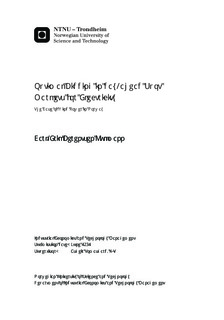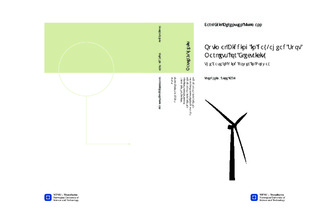| dc.contributor.advisor | Tomasgard, Asgeir | nb_NO |
| dc.contributor.author | Kullmann, Carl-Erik Berentsen | nb_NO |
| dc.date.accessioned | 2014-12-19T14:28:42Z | |
| dc.date.available | 2014-12-19T14:28:42Z | |
| dc.date.created | 2013-06-16 | nb_NO |
| dc.date.issued | 2012 | nb_NO |
| dc.identifier | 629202 | nb_NO |
| dc.identifier | ntnudaim:7317 | nb_NO |
| dc.identifier.uri | http://hdl.handle.net/11250/266306 | |
| dc.description.abstract | Through the last decades, climate change and energy dependence concerns have gained increased attention. Renewable energy development has expanded, with wind power being the fastest growing technology. This thesis investigates the op- timal interaction between an operational wind park and the Nordic power market. Wind power producers incur costs of imbalances resulting from deviations from their submitted production plans to the spot market. This report develop, im- plement and test a stochastic optimisation model giving optimal spot market bids for intermittent electricity producers in a day-ahead power market. The optimal bids are based on the evaluation of a large number of scenarios for the uncertain realisations of the wind forecasts, the balancing market prices and the spot market prices. A case study is undertaken in order to evaluate model performance. Data is collected for specified dates at current and future wind power sites of a Norwegian company. The developed stochastic optimal bidding model is executed, once for each wind park individually and once for all wind parks jointly. The case study re- veals that jointly use of the model gives expected revenues higher than both the sum of individual use and submission of bids equal expected production. The increase in expected revenues results from a risk-pooling effect of jointly bid submission and from the inclusion of price and production uncertainty. The risk-pooling effect also suggests that wind park owners would benefit from geographically diversifying their wind parks within the same price area. Use of the developed model gives rather small increases in expected revenues and is likely to violate the Balance Agreement. However, investigations of model results give basis for further discussions. Examinations of the case study results show that perfect production forecasts would make the inclusion of uncertainty unnecessary, indicating that efforts should be made in order to reduce the uncertainty of the production forecasts, rather than on improving the price forecasts. From a socio-economic point of view, the regulation costs incurred to wind power producers represents a reduction in value from introducing wind power to the power system. Some of the potential value of wind power is lost, through what can be seen as transaction costs of the current power market. It is suggested that delaying the spot market bid submission deadline, which in turn reduce the wind forecast lead-time and hence uncertainty, would increase the value of introducing wind power to the power system. Further research should be undertaken in order to investigate the optimal spot market bid submission deadline, minimising all costs related to this deadline. | nb_NO |
| dc.language | eng | nb_NO |
| dc.publisher | Institutt for industriell økonomi og teknologiledelse | nb_NO |
| dc.title | Optimal Bidding in day-ahead Spot Markets for Electricity: The Case of Wind Power in Norway | nb_NO |
| dc.type | Master thesis | nb_NO |
| dc.source.pagenumber | 65 | nb_NO |
| dc.contributor.department | Norges teknisk-naturvitenskapelige universitet, Fakultet for samfunnsvitenskap og teknologiledelse, Institutt for industriell økonomi og teknologiledelse | nb_NO |

